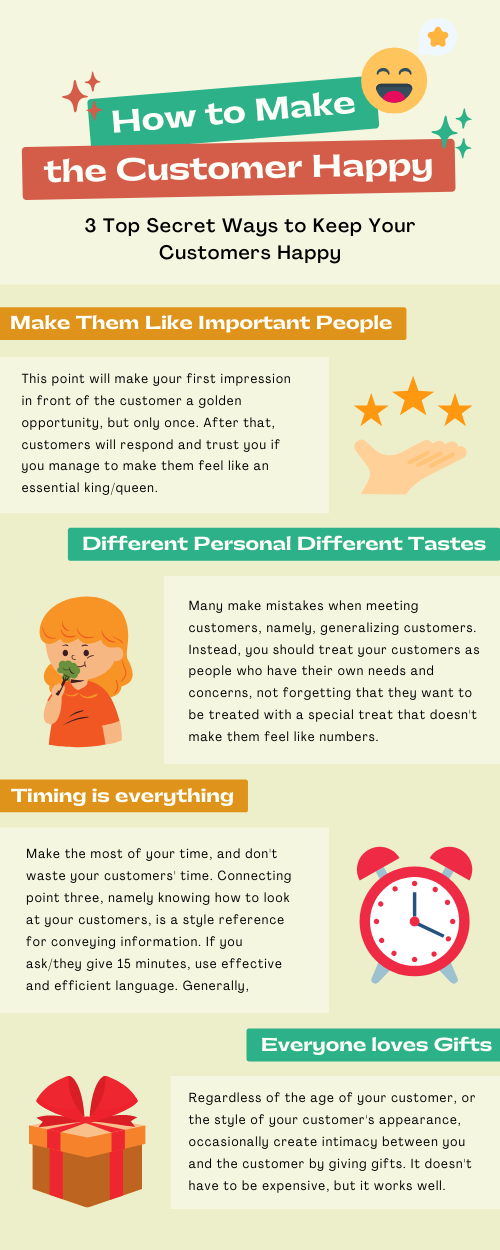When done correctly, customer service can lead to increased sales and a loyal fanbase. Implementing quality customer service practices acknowledges the valuable needs of your customers, establishes trust between you and them, builds goodwill among your customers, and increases the chances that they will return in the future–all of which is beneficial to your business.
The art of customer service can be incredibly challenging, but with the right strategies in place it can be tremendously rewarding. It’s essential for businesses to have a sound understanding of their customers, their needs and wants, and how best to meet them. Building a strong customer relationship is one of the most important things you can do to keep your business thriving. Too often we see companies discount or ignore their customers in favor of doing things “the way we always have done it”–only to find that this leads to disgruntled employees as well as unhappy customers.
Increased customer satisfaction:
Customer service skills enable a business to better understand and meet the needs of their customers. Excellent customer service will ensure that their customers are happy and satisfied with their products or services, which can lead to repeat business, positive word-of-mouth referrals, and increased revenue.
Improved brand reputation:
A business that provides exceptional customer service is likely to have a positive brand reputation. This can help attract new customers and retain existing ones, as well as distinguish the business from its competitors.
Higher employee morale:
Employees who are trained in customer service skills are more likely to feel confident in their ability to interact with customers and provide solutions to their needs. This can lead to higher employee morale and job satisfaction, which can result in improved productivity and reduced employee turnover.
Better problem-solving skills:
Customer service skills involve the ability to listen, understand, and address customer concerns and complaints. By mastering these skills, businesses can better identify and resolve problems before they escalate, which can save time and resources.
Increased profitability:
Happy and satisfied customers are more likely to make repeat purchases and recommend a business to others. This can lead to increased profitability, as businesses can reduce the cost of acquiring new customers and increase revenue from existing ones.
Now, let’s delve into 5 tips on achieving exceptional customer service.
This post contains affiliate links. Please read our disclosure.
1. Be Proactive

Proactivity is the key to delivering outstanding customer service. You’ll not only show that you are paying attention, but you also demonstrate that you are committed to going above and beyond to exceed their expectations. When you are proactive, you are able to quickly identify potential issues, take steps to resolve them, and prevent them from happening in the first place. This can save your customers time, hassle, and frustration, and ultimately lead to a better overall experience. It’s important to be knowledgeable about your product or service, as well as your customers’ needs and preferences. You can use data analysis and customer feedback to identify patterns and trends, and use this information to anticipate their needs and provide solutions before they even ask for help. This can help build trust with your customers, and lead to a more positive and long-lasting relationship.
2. Listen Actively
Active listening is a critical skill for anyone in a customer service role. When you listen actively, you show that you are truly interested in what your customers have to say, and that you are committed to understanding their needs and concerns. This can help you identify opportunities to improve your service, as well as build stronger relationships with your customers. Focus on what your customer is saying, ask open-ended questions to clarify their needs, and repeat back what you understand to ensure that you have accurately captured their concerns. You should also pay attention to nonverbal cues, such as tone of voice and body language, as these can provide additional insight into your customer’s experience.
3. Be Empathetic

Empathy is a powerful tool for building strong relationships with your customers. When you are empathetic, you show that you understand and care about their experience, and are committed to helping them find a solution to their problem. This can help your customers feel heard and valued, and ultimately lead to a more positive overall experience. Put yourself in your customer’s shoes and try to understand their perspective. You should acknowledge their frustrations and concerns, and take steps to address them in a timely and effective manner. You should also be patient, kind, and understanding, even in difficult situations. By showing empathy, you can build trust with your customers, and create a more positive and long-lasting relationship.
4. Follow Up
Following up with your customers after resolving an issue is a critical component of excellent customer service. When you follow up, you show that you truly care about their experience, and are committed to ensuring that they are satisfied with the resolution. This can help build trust with your customers, and ultimately lead to a more positive overall experience. Strive to be timely and professional. You should check in with your customer to ensure that the issue has been resolved to their satisfaction, and ask if there is anything else you can do to help. You should also thank them for their business, and let them know that you value their feedback. By following up, you can create a more positive and long-lasting relationship with your customers.
5. Continuously Improve

Continuous improvement is essential in any customer service role. By continually looking for ways to enhance your service and exceed your customers’ expectations, you can stay ahead of the competition and create a more positive overall experience for your customers. Gather feedback from your customers, analyze data on their experiences, and identify areas where you can make improvements. This can involve making changes to your products or services, improving your communication strategies, or investing in new technology to better serve your customers. You should also stay up-to-date on industry trends and best practices, and be open to learning and trying new things. Continuous improvement is an ongoing process, and requires a commitment to excellence and a willingness to embrace change. By making it a priority, you can stay competitive in your industry and deliver exceptional service to your customers.
Conclusion
Mastering the art of customer service requires a combination of skills and strategies. By being proactive, listening actively, being empathetic, following up, and continuously improving, you can delight your customers and build strong relationships that last. These tips are just the beginning, and there are many other strategies that can help you deliver exceptional service. With dedication, hard work, and a commitment to excellence, you can become a customer service superstar and take your business to new heights.

Ready to start your blogging journey? Access the tools, tips, and resources that will guide you every step of the way. Don't wait—unlock your potential as a successful blogger today!
Namecheap
Affordable domain registration, free privacy protection, and reliable hosting.
Pricing: $1.98/year (domain) | $2.88/month (hosting)
Best For: Budget-conscious website owners
Shopify
Customizable e-commerce templates, built-in payment processing, and marketing tools.
Pricing: $29/month
Best For: E-commerce stores and online businesses
GetResponse
Email marketing, automation tools, landing pages, and webinars.
Pricing: $15/month
Best For: Bloggers and marketers growing their audience



